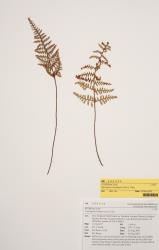Terrestrial or rupestral ferns. Rhizomes long-creeping (NZ) to short-creeping (not NZ), scaly. Rhizome scales non-clathrate, narrowly ovate to acicular, attached at base, concolorous or bicolorous, light to dark brown. Fronds monomorphic. Stipes and rachises red-brown (NZ) to black (not NZ). Laminae 3–4-pinnate (NZ), or 2-pinnate (not NZ), herbaceous or coriaceous, scaly and/or hairy (NZ) or rarely glabrous (not NZ). Pinnae and ultimate lamina segments not articulated to rachis and costae. Veins free. Sori terminating veins at lamina margin; sori protected by strongly (NZ) to poorly (not NZ) modified inrolled lamina margin. Spores trilete, lacking chlorophyll; perispores cristate to rugulate, without an equatorial flange.
A genus of c. 45 species, included in the subfamily Cheilanthoideae along with Cheilanthes and Pellaea (PPG 1 2016).
Myriopteris was separated as a monophyletic genus (Grusz & Windham 2013) from the polyphyletic Cheilanthes (Eiserhardt et al. 2011; Zhang & Yatskievych 2013; PPG 1 2016). It is largely confined to North and Central America.
Myriopteris is distinguished from Cheilanthes by its production of 64 small spores per sporangium in sexual species and 32 large spores per sporangium in apomictic species, compared to 32 small or 16 large spores in Cheilanthes. The spores are mostly cristate or rugulose in Myriopteris, but echinate, granulose or verrucate in Cheilanthes. The vein endings near the lamina margins in Myriopteris are not obvious, but in Cheilanthes there are often prominent hydathodes.
Myriopteris lendigera (as Cheilanthes lendigera) was recognised as a casual species in New Zealand by Heenan et al. (2004).
In New Zealand, the sole species of Myriopteris can be recognised by its 3–4-pinnate fronds with small, rounded ultimate segments, long orange hairs on the abaxial surface, and stipes that are generally longer than the laminae.
Myriopteris is distributed from southern Canada through the Caribbean and Central America to Chile, with one species also present in Namibia and South Africa (Grusz & Windham 2013). There is one species casual in New Zealand.
| Category | Number |
|---|---|
| Exotic: Casual | 1 |
| Total | 1 |
Base chromosome numbers of x = 29 and 30 have been recorded in Myriopteris. Diploid, triploid and tetraploid species are known, and some are apomictic (Grusz & Windham 2013).




